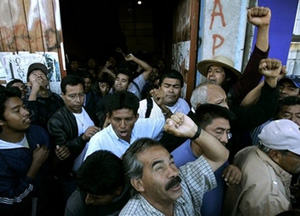 |
 |
 |
 Editorials | October 2006 Editorials | October 2006  
Radical Teachers Defy Death Squads
 Elizabeth Mistry - NewsQuest Elizabeth Mistry - NewsQuest


| | Teachers shout slogans after of an assembly of teachers at hotel in the center of the city where a vote was scheduled in Oaxaca City in Mexico, Sunday Oct. 22, 2006. After an all-night meeting in a Oaxaca hotel, a majority of union delegates voted to end the strike, which is affecting 1.3 million children across Oaxaca state. However, advocates of continuing the strike managed to get the vote annulled, arguing it had been manipulated by union leader Enrique Rueda, who has called for the teachers to get back to work. (AP/Eduardo Verdugo) |
They’re embroidering pine apples on the streets of Oaxaca. Everywhere you look – if you can see past the makeshift barricades blocking the streets leading on to what was once one of Mexico’s prettiest squares – the Zocalo, small groups of teachers, mostly women, are huddled together stitching; “to calm our nerves,” says one woman as she finishes a three-dimensional pineapple.

While at first glance a passer-by might mistake them for a sewing circle, these women are on guard. For more than five months, almost the entire teaching body, some 70,000 men and women, has been on strike, demanding the resignation of the state governor who spent the education budget on a vanity project instead of staff wage increases and school materials.

The barricades have prevented any traffic reaching the square. Tourism, which kept the city alive, has all but dried up, and of the dozens of cafés and bars where one could sip a drink while savouring the local snack, dried grass hopper dipped in chilli, only two are open. The local economy has nosedived, and workers are leaving in droves for cities as far away as Cancun.

“Our schools are the worst in the country,” one maestra (teacher) told the Sunday Herald. “We have nothing. Nothing to give the pupils, some of whom walk miles to get here every day. We have no books, no paper, not even a pencil. Usually we have to provide the materials ourselves out of our own wages, and we’re fed up of doing that.”

There’s been a lot of beating in Oaxaca recently. Last year, shortly after he claimed victory in what is widely seen as a rigged election, the governor, Ulysses Ruiz, sent in police to “restore order” at the local paper after it started printing articles that questioned how members of his cabinet were able to acquire expensive property.

Earlier this month, student activist Pedro Garcia was walking home with his girlfriend when a car skidded to a halt in front of them. “I knew immediately what was happening and I pushed my girlfriend away and shouted at her to run. They grabbed me and threw me in the back of the car, shoving me down into the gap behind the seats,” he said.

“Much later, when they began asking me about the names of other student leaders, they started beating me. Not in the way the ordinary police do, but round here, and here,” he said, showing his upper torso, which, apart from a large welt on his side, appears surprisingly unmarked. “That was when I knew for certain they were not ordinary police. If they beat you for seven hours you would end up black and blue.”

Garcia was held incommunicado for several days before he was released last week, following an appeal by Amnesty International, which expressed concern for several protesters who had been disappeared in recent days.

The morning following his release he was back in the Zocalo, still occupied by several hundred striking teachers as well as members of APPO, the state-wide popular movement calling for Ruiz’s dismissal and new elections.

The teachers say they are determined to stay until Ruiz resigns or until the senate in Mexico City rules he has lost the ability to control the state. With more than eight dead – two more teachers have been killed in recent days, reportedly by nocturnal hit squads – those who stay are running huge risks.

The federal government, reluctant to sack Ruiz because it fears the outbreak of similar protests across the country, has put the navy on standby, hoping that might be enough to scare the protesters off. But for the time being more than half remain, in spite of a call by the teachers’ leader to return to work.

“We are concerned at the reports of ill-treatment of detainees and that the alleged killers of the teachers have yet to be detained,” says Rupert Knox, Mexico researcher at Amnesty International. “This suggests a failure on the part of the authorities to safeguard the right to protest peacefully and a worrying deterioration in the human rights situation.” | 
 | |
 |



